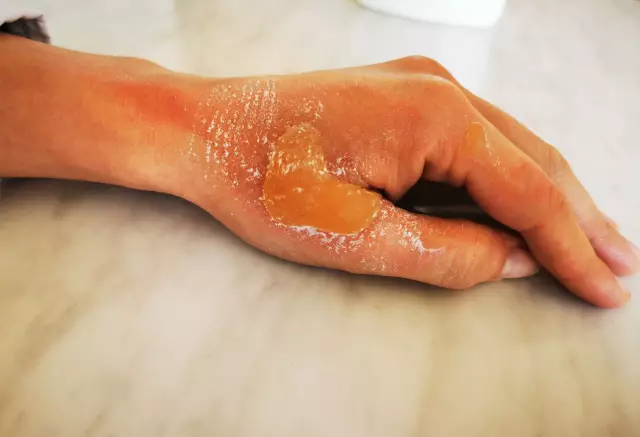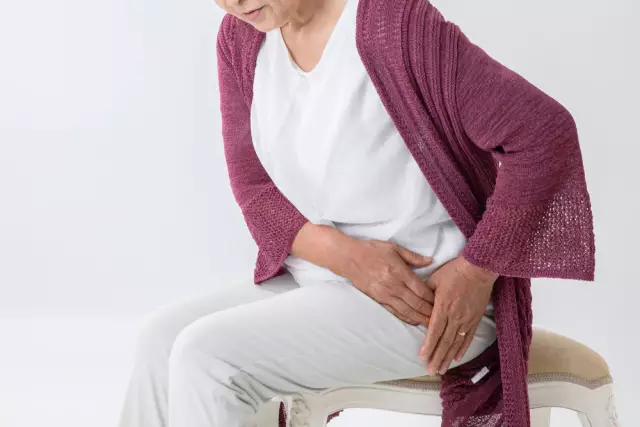- Author Curtis Blomfield [email protected].
- Public 2023-12-16 20:44.
- Last modified 2025-01-23 17:01.
Human hip bones connect the lower extremities to the body. Since we walk and move actively every day, they carry an enormous load. Therefore, when pain appears in this area, you should immediately consult a doctor. After all, discomfort can be the first "bell" of a serious illness that will lead to irreparable disability.
Dysplasia and Congenital Dislocation
These diseases are usually diagnosed in infants. Dysplasia is a defect in the development of the joints, leading to a violation of the supporting function of the limbs. In this case, the neck and head of the femur are incorrectly positioned in relation to the acetabulum. Causes - heredity, breech presentation of the fetus, endocrine disorders, infections, age of the parents. It is not difficult to diagnose the disease: in children, one leg is shortened, it is difficult to spread the limbs to the sides, and you can hear a click. The baby has a noticeable bend in the spine, he starts walking late, lameness is possible. mosta neglected degree of dysplasia is a congenital dislocation of the hip - underdevelopment and displacement of the hip bone.

The sooner the doctor noticed violations, the easier and faster to get rid of the disease. Usually, the specialist prescribes a special set of exercises, which includes massage and physiotherapy exercises. The baby needs to be swaddled widely, bring him to the clinic for water procedures. In some cases, he is advised to wear splints or orthopedic pants. Plaster manipulations also help - the final formation of the joint, which occurs before the age of six months.
Peters disease
This is a violation of the blood supply to the hip bone, as a result of which the nutrition of the articular cartilage deteriorates sharply. The causes of Peters disease are different: injuries and excessive stress on the joints, improper metabolism, past infections, congenital problems and genetic predisposition. According to statistics, boys (from 3 to 14 years old) suffer more often from the disease, while the predisposition is noticed if at birth their weight was less than 2 kilograms. The disease develops gradually: first, the baby's hip and kneecap hurt, then the gait changes. Sometimes the temperature rises, a general blood test indicates an inflammatory process in the body.

Treatment of the disease depends on the age of the child and the stage of the disease. In any case, doctors advise to reduce the load on the joints: they prescribe crutches, therapeutic mud, physiotherapy, and massage. The patient wearsspecial orthopedic arrows and is amenable to drug therapy. In too advanced cases, surgical intervention is necessary.
Epiphyseolysis
Another childhood disease, when dystrophic changes occur in the area of the femoral neck, which subsequently deform it. It is observed in adolescents at the age of 12-15, in whom the muscles are undeveloped, and the subcutaneous layer of fat is hypertrophied. At the same time, the hip joint, the bones in this area lose their mechanical strength due to increased activity of growth hormone. The disease is usually bilateral, developing after a minor injury or without any significant reason. Warning symptoms include pain in the groin and knees, poor hip mobility, sometimes accompanied by high blood pressure and rapid weight gain.
Treat juvenile epiphysiolysis using conservative methods. If the child has not reached the age of 10, they stretch his leg on a splint or an inclined plane, take it away for eight weeks and do an internal rotation. An alternative is the imposition of a plaster cast for several months. If the disease is not diagnosed in time, it leads to serious complications.
Osteoporosis
This is a pathology in which phosphorus and calcium necessary for it are "washed out" from the bone tissue. Bones become weak, porous, they often break. Damage can be obtained as a result of a fall from a height of its own weight or after a banal bruise. Osteoporosis affects almost the entire skeleton. As for the hip bone, the most vulnerable place for the disease is the neck. fracturehip bone in this place is very dangerous, in the elderly it often ends in death.

Since more women are affected by the disease, the main causes of its occurrence can be attributed to menopause, when estrogen production drops sharply. The pathology of the endocrine system, organ transplantation, poor nutrition, old age, alcoholism, taking medications, and poor heredity are also capable of provoking the development of the disease. The main symptoms are back pain, stoop, leg cramps, chest deformity. Treatment consists in the patient taking medicines: anabolic, antiresorptive, as well as hormones and vitamins.
Hip Fracture
There are three types of such damage: the distal or lower end, the proximal or upper part, as well as the body of the bone itself. In addition, a trochanteric injury and a fracture of the femoral neck are diagnosed. Most often, people over 65 years of age, women after menopause, get injured. In young people, a fracture is diagnosed after car accidents, falls from a height, and so on. The first signs of damage to the hip bone are as follows: severe pain in this area, inability to move, a person has one of the limbs severely shortened, the foot is turned outward, he cannot even tear off his heel from the surface of the bed. Moreover, the greater the angle of the fracture, the higher the risk that it will not heal.
If a person is diagnosed with a hip fracture, both conservative and surgical treatment is prescribed. Firstis the prolonged absence of movement of the limb. This method is ineffective and is contraindicated in the elderly. Therefore, if there are no special prohibitions for surgical intervention, doctors prescribe an operation. When the femoral neck is broken, endoprosthesis is done - they change the native joint or only part of it to a mechanical analogue.
Arthritis
The disease implies the presence of inflammatory processes in the joint. It occurs due to impaired metabolism, due to poor immunity, overwork and excessive stress on the leg, and also as a complication after infections and viruses. In this case, the symptoms depend on the type of disease. For example, with purulent arthritis, the temperature rises sharply. With other varieties of the disease, symptoms appear gradually: from mild aching pains to lameness.

When the hip bone is prone to inflammatory processes, the doctor prescribes many procedures, as well as special exercises, massage, spa treatment. You can't do without medication. Also, tight bandages are constantly applied to the affected leg to ensure the immobility of the joint. In some cases, surgical treatment is provided: sanitation of inflammatory foci and restoration of joint functions. Even after discharge, the patient will undergo a rehabilitation course for a long time.
Bursitis
This is an inflammation of the bursa - the synovial bag of the hip joint. Occurs due to physical activity or after an injury. At first, the patient feels a burning pain in the area wherethe hip bone is located. It grows rapidly, preventing a person from bending a limb or walking normally. The patient is especially tormented at night, because during rest the symptoms intensify to such an extent that it becomes impossible to lie on the injured side.

Treatment of bursitis is simple. Most often, it is enough to simply take anti-inflammatory drugs and observe bed rest. The patient is also required to perform exercises that are aimed at stretching the tibial tract and strengthening the buttocks. If the case is severe, the doctor will prescribe injections of glucocorticoids, physiotherapy - ultrasound or electrophoresis, as well as surgery. The prognosis for recovery is usually positive. You can return to normal life in two months.
Synovitis
The wide hip bone is often prone to this disease - inflammation of the synovial membrane of the joint. Often becomes the cause of lameness in children, in most cases in boys from 3 to 10 years. Occurs as a complication after trauma or SARS. Symptoms appear quickly and develop rapidly, they are very similar to the signs of tuberculosis. The patient feels limited in movements, his joints hurt, muscle spasms are observed. Fever and fever are recorded in rare cases.
Basically, doctors prescribe such patients antibacterial and anti-inflammatory drugs, a puncture to remove the contents of the joint bag, and recommend fixing the injured leg. During the first days it is necessaryminimize physical activity, but after a week you can return to a full existence. By the way, traditional medicine recommends thyme, rye, St. John's wort, mistletoe and other herbs to combat synovitis.
Aseptic necrosis
This is one of the most severe diseases that affects the hip bone. Represents the necrosis of the tissue of the femoral head due to circulatory disorders. Factors contributing to the development of the disease are neck fractures, dislocations, high pressure (in miners, divers and cavers), alcoholism. A certain disease can also serve as a cause: osteoporosis, rheumatoid arthritis, lupus erythematosus, and so on, as well as taking medications and a cold. If the disease is not treated, the head of the femur will be completely destroyed.

Symptoms include sharp pain when standing on a sore leg or walking. Necrosis of the hip bone provokes the appearance of lameness, limits the mobility of the limb. An x-ray is needed for diagnosis. As for the choice of treatment, it depends on the stage of the disease and the characteristics of the human body. Surgery to restore blood flow, bone decompression, or autograft transplantation is usually recommended. In the later stages, endoprosthesis is performed using mechanical joints.
When to see a doctor?
When you are concerned about the hip bone, treatment should be started immediately. If the pain restricts your usual life and does not go away for threedays, contact the clinic. The doctor will make a diagnosis using various devices: MRI, X-ray, ultrasound. To establish the correct diagnosis, he will appoint you a consultation with other specialized specialists, a detailed history will also be collected and all kinds of tests will be carried out.

Remember that ignoring pain can lead to irreversible consequences. A person who does not treat hip ailments runs the risk of becoming disabled. The sooner you seek help, the more effective the therapy will be. The patient will be able to recover quickly and easily, and will also spend less money. In fact, all such diseases in the first stages are treated without problems using conservative methods. Endoprosthetics is indicated only in case of complications. Take care of your he alth!






